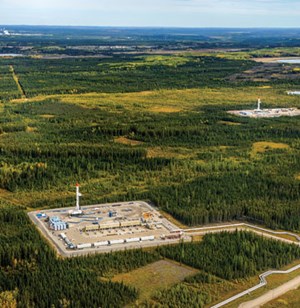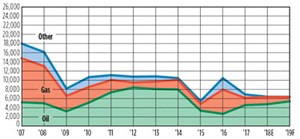Canada expects a quiet, flat year for E&P activity
Aside from the economic uncertainties still weighing down activity—the recovery in oil prices did not extend to Alberta for most of 2018 (Fig. 1)—the biggest issue facing producers is on the political front. With elections looming in Alberta this spring, and federally this fall, much is up for grabs as the different parties jockey for position.
Pipeline chaos. At the heart of the chaos is the issue of pipeline development, which has proved to be divisive and polarizing, with local politicians more than willing to abandon all reason or thoughts of national interest in the hopes of being re-elected.

In British Columbia, the provincial government continues to fight the Trans Mountain pipeline expansion, despite backing other pipeline projects that suit its local needs, and refusing to tackle the issue of dumping raw sewage into lakes, waterways and the Pacific Ocean. In all of Canada, B.C. is the worst offender in this category. In fact, a recent report suggests that the province dumps over 34 million gal of untreated sewage into the ocean daily. And the provincial capital, Victoria, is home to the one of the largest coal exporting facilities in Canada.
The behavior from B.C. politicians has gotten so bad that certain municipalities have banded together and are talking about launching a class action lawsuit against oil and gas companies for climate change. As patently ridiculous as that concept is, and as hypocritical, the holier-than-thou sentiment seems to be growing, further dividing Canada along regional lines.
In Quebec, the hypocrisy is even more startling. Since the concept of equalization payments was established in Canada, provinces are divided into two categories, based on their economic performance: have, and have-not. The concept is to spread the wealth evenly across all of the confederation, to ensure that all Canadians benefit equally from the country’s vast natural resources.
So, oil-rich Alberta has paid often, and handsomely, into the system. Quebec, despite its frequent insistence that it is a sovereign state within Canada, has received more than $200 billion in payments from the program. Despite this, the province has staunchly opposed any proposed pipeline that would ship western oil to eastern refineries, so Canada, instead, regularly imports oil from Saudi Arabia, Nigeria and other similar regimes, which have little or no regard for environmental protection, much less human rights, one of Prime Minister Justin Trudeau’s most frequent talking points.
Alberta’s production cut. In Alberta, frustrated with constant prevaricating from Trudeau, the government has intervened in the market on several fronts. Aside from developing a made-in-Alberta climate change plan (designed to achieve the same results as federal requirements, but at a fraction of the cost), Premier Rachel Notley also has announced plans to buy railcars to increase market access, provided a $440-million loan guarantee to Value Creation Inc. (to build a $2-billion upgrading facility east of Edmonton), and imposed production cuts on almost 30 Alberta oil producers, in an effort to reduce the massive discount Alberta oil was receiving on the open market. (Canadian producers are still often selling their oil at a significant discount between the Western Canada Select benchmark price and West Texas Intermediate, due primarily to ongoing market access constraints.)
The first cut, imposed in late 2018, but effective Jan. 1, 2019, reduced Alberta production by 325,000 bopd. Affected producers were mixed in their response, with some claiming that the market intervention would have potentially damaging long-term effects on their operations and market dynamics. Others supported the idea. But once the cuts were put into effect, certain producers, some of which formerly supported the OPEC-style intervention, reversed their stance after some unanticipated consequences became apparent, like impacts to regional operations. Ironically, one of the other issues curtailment created was to make shipping by rail uneconomical, as the more expensive rail shipments require a higher differential. Such is the world of interventionist policy.
Provincial officials subsequently reduced the cuts by 75,000 bopd. The program was originally planned to run for all of 2019, but with a provincial election scheduled to occur this spring, the long-term fate of the program is unknown. In the short term, the markets responded almost immediately, and the differential has closed to less than C$10 per barrel in January.
Vague federal policy. Meanwhile, on the federal front, the Trudeau administration continues to send mixed messages on its view of the oil and gas industry. Currently, the concern resides with Bill C-69, which would replace the National Energy Board (NEB) with a new entity, the Canadian Energy Regulator, as well as shift much of the NEB’s power to a new Impact Assessment Agency. Most parties that know the oil and gas industry have raised similar concerns about the proposed change, including longer review times, less legal certainty about its decisions (creating more appeal mechanisms), requiring Environmental Impact Assessments for much smaller projects, and increased red tape and process.
In short, the bill that is purported to streamline the current system will do the opposite, making it almost impossible for the newly minted agency to issue approvals on anything put before it. Skeptics believe Trudeau’s true objective is to shut down Alberta’s oil sands, citing his government’s tanker ban on the West Coast, while continuing to allow tankers to travel up the St. Lawrence Seaway in eastern Canada.
With so much uncertainty, industry has responded by delaying or canceling projects, reducing spending, and limiting its exposure to the current negative market conditions. As a result, land sale revenues and drilling numbers are once again trending downward.
One piece of positive news is the poor performance of the Canadian dollar, which has dropped in value to 75 cents, U.S., well below the 80-cent mark it was at last year, at this time. The low Canadian dollar benefits the export-driven oil and gas industry, which still ships substantial volumes of oil and gas south to U.S. customers. But as is often the case, as oilpatch fortunes rise, so does the dollar, which negates some of the benefits accrued from improved pricing.
Optimism on the pipeline front also has dimmed considerably over the past year. Keystone XL remains in limbo, pending a Trump administration appeal of the November ruling from U.S. District Judge Brian Morris that blocked a construction permit for the 1,900-km (1,181-mi) pipeline.
And the Trans Mountain expansion is now the subject of a reconsideration by Canada’s National Energy Board after the Federal Court of Appeal overturned its approval last summer. The court ordered the NEB to further examine the impact of tanker traffic on the marine environment off the coast of B.C., and conduct additional consultation with indigenous groups. The report is due on Feb. 22.
Drilling remained more or less flat in 2018, but the outlook for the year ahead is significantly more bearish than it was a year ago. According to Daily Oil Bulletin records, of the 6,939 wells drilled last year, almost 76%, or 5,260, were estimated to be oil wells, compared to about 74% of the total in 2017. Overall, drilling dropped by just under 2%, from the 7,091 drilled in 2017. Exploratory drilling decreased to 278 wells in 2017, or less than 4%, compared to 305 the year before.
In Alberta, drilling was basically flat in 2018, dropping 1%, with 3,656 wells drilled, compared to 3,699 the year before. In Saskatchewan, drilling was up 1%, with 2,557 wells drilled, versus 2,530 in 2017. In British Columbia, operators drilled 438 wells in 2018, down 29% from 614 wells in 2017. And in Manitoba, drilling rose almost 15%, to 276 wells in 2017, compared to 240 the previous year.

For the year ahead, the Canadian Association of Oilwell Drilling Contractors is predicting that drilling will remain flat, with 6,962 wells drilled, and rig contractors delisting 10% of the Canadian rig fleet. Meanwhile, the Petroleum Services Association of Canada is far more bearish, calling for a total of 5,600 wells drilled, a decrease of more than 19%.
The Canadian Association of Petroleum Producers, like CAODC, expects a flat year, with 6,410 wells predicted, vs. 6,416 in 2018. CAPP says that Canadian oil production jumped 13.4% higher, to 4.5 MMbopd, from more than 79,000 active oil wells across the country.
Land sales fell significantly in 2018, with industry doling out C$527.1 million in Western Canada, down 34% from the $793.3 million collected in 2017. The downward trend at such a crucial time is a clear indicator of industry’s misgivings about the year ahead. In sharp contrast is the record high of $5 billion in 2008, when industry was truly booming.
In Alberta, spending reached $411.4 million, a drop of 26% from last year’s total of $556.4 million. It was two years ago that Alberta collected just $148.6 million, making 2016 the lowest total recorded in Alberta in more than 20 years.
British Columbia and its anti-oil administration took the biggest hit, collecting a meager $64.1 million in bonus bids, down 63% from last year’s $173.3 million. B.C. posted its all-time low in 2016, collecting just $15.2 million. The province also recently announced there were no rights put up for bids in its February auction.
Saskatchewan experienced a slight decline, to $50.7 million, decreasing just over 19%.
Land inventories are one of the most consistent indicators of future drilling activity; so this increase in land sale volumes is a welcome portent that better times may indeed lie ahead. ![]()
- Coiled tubing drilling’s role in the energy transition (March 2024)
- Advancing offshore decarbonization through electrification of FPSOs (March 2024)
- The reserves replacement dilemma: Can intelligent digital technologies fill the supply gap? (March 2024)
- The last barrel (February 2024)
- Oil and gas in the Capitals (February 2024)
- What's new in production (February 2024)
- Applying ultra-deep LWD resistivity technology successfully in a SAGD operation (May 2019)
- Adoption of wireless intelligent completions advances (May 2019)
- Majors double down as takeaway crunch eases (April 2019)
- What’s new in well logging and formation evaluation (April 2019)
- Qualification of a 20,000-psi subsea BOP: A collaborative approach (February 2019)
- ConocoPhillips’ Greg Leveille sees rapid trajectory of technical advancement continuing (February 2019)


